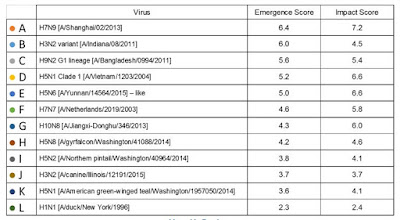 |
| Credit NIAID |
#12,273
Last summer - before H5N8's epizootic conquered Europe, prior to the arrival of H5N6 to South Korea, Japan, and Taiwan, and at the tail end of the lightest wave of H7N9 we'd seen since it emerged in 2013 - we looked the CDC's Influenza Risk Assessment Tool (IRAT) (see CDC: IRAT Evaluation Of Novel Avian & Swine Flu Risks).
Using a variety of parameters, IRAT attempts to quantify non-human flu viruses in two broad categories
- Potential Emergence Risk: The likelihood that a particular virus will become transmissible among humans
- Potential Impact Risk: And its impact (based on virulence, population immunity, etc.), should it become a pandemic strain
While IRAT can't predict which virus will become a pandemic strain (or when), it can help planners decide which viruses pose the greatest risks, so they can prioritize their efforts and investments.
Of the 11 influenza subtypes/strains circulating in non-human hosts evaluated with IRAT:
- 5 were listed as having a moderate Potential Emergence Risk.
- 5 were listed as having a moderate Potential Impact Risk
- Only 1 (H7N9) was listed as having High-Moderate Potential Impact Risk
Since our last look at this tool, a 12th virus has been added (H3N2 [A/canine/Illinois/12191/2015]).
With avian flu on the ascendant around the globe (see A New Avian Flu Review) the CDC has updated their IRAT web pages with new charts and graphs. You'll find your questions answered on the Influenza Risk Assessment Tool (IRAT) Q&A page, while the virus evaluations may be found at:
Summary of Influenza Risk Assessment Tool (IRAT) Results
The Influenza Risk Assessment Tool (IRAT) is an evaluation tool conceived by CDC and further developed with assistance from global animal and human health influenza experts. The IRAT is used to assess the potential pandemic risk posed by influenza A viruses that are not currently circulating in people. Input is provided by U.S. government animal and human health influenza experts. Information about the IRAT is available at Influenza Risk Assessment Tool (IRAT) Questions and Answers.
Below is a table of results for influenza A viruses that have been assessed using IRAT because they serve as a representative of a particular subtype or are of unique interest.
(Continue . . . )
As flu viruses evolve, so will these evaluations.
While H7N9 was last scored in April of 2016, given its recent surge and the emergence of an HPAI version in Guangdong Province, I imagine the CDC is anxious to get their hands on fresh data so they can run it again.
Eight of the 12 viruses on this list have emerged over the past 6 years, a testament to how quickly influenza continues to evolve in this 21st century.
A trend that seems likely to continue, given the proclivity for these viruses to reassort with other viruses as they spread around the world.


